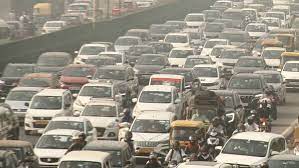Delhi Pollution is a pressing issue, in light of this Delhi government will impose a car restriction regulation in the Capital for a week after Diwali. This measure should reduce the post-Diwali peaks of pollution in the city. Government predicts that crackers to be released in neighbouring states will just worsen the case; since, air pollution already remains in the most serious grade for the last six days. Odd-even formula implies that private cars bearing odd and even numbers will run on roads in turn. This implies that only one-half of the cars will be in use per day, translating to a fifty percent reduction in the amount of vehicular pollution.
From November 13 through 20, the odd–even car ratio rule will be implemented by the Government of Delhi. The intent of this measure is to cut down Diwali peak pollution peaks in the city.
What is the odd-even rule?
Traffic control means odd-even rule that private vehicles that have registration numbers ending at odd digits may participate in transport movement on each day with an odd date. Vehicle restriction scheme permits cars accessing in a day depending on their plates of being odd or even. Even an odd plate series will only be allowed in their corresponding days. Other days, those with an even digit can only be driven.
Also read: Delhi at High Alert| Rs 23 cr smog tower stands ‘non-functional’
For instance, cars with odd number plates will only drive on Monday, Wednesday and Friday days. On Tuesdays, Thursdays, and Saturdays, only vehicles with even numbers will be allowed.
The odd-even policy was first brought out by the Delhi government during the rule of the Aam Aadmi party at that time as an attempt to reduce vehicular emission and falling PM levels.
Impact of the odd-even scheme:
As per studies, odd-even policy made a difference towards Delhi traffic jams. The frequency of cars, buses and the Delhi metro also increased hence increasing occupancy rates in cars.
Some results of the scheme include:
- Travel speeds: This led to a reduction of car travel speeds by as much as 16%.
- Travel times: Up to 20 percent was added on car travel times.
- Bus speeds: There was a reduction of almost 30 percent in bus speeds.
- Bus travel times: It took an extra 40 percent in bus travel time.
- Car occupancy rates: Car occupancy rates increased
- Bus and metro ridership: Bus ridership and the usage of the Delhi metro rose.
- Pollution levels: Pollution levels dropped slightly
- Air quality: Air quality improved
Nevertheless, other studies show that the odd-even rule failed to decrease measurable PM2.5 air pollution in Delhi.
Other measures that will be implemented include:
- the ban of BS-III petrol cars and BS-IV diesel will continue.
- No construction activities shall take place in the city.
- Pupils will not attend classes till grade eleven in schools.
- Delhies introduced the odd-even formula for controlling pollution in 2016. This led the state government to recall the initiative in 2019.
The odd-even scheme exempts the following vehicles:
- Two-wheelers
- Single women and mothers with children below 12 years.
- For private vehicles with school children in uniform but between 7 am to 5 pm.
- People having some physical disabilities.
- The vehicles consist of those for the president, vice-president, the prime minister of India, chief justice of India, speakers of lok sabha and union cabinet ministers of India, leader of opposition of both houses (Lok Sabha and Rajya Sabha) and Governors.
- Vehicles used for medical emergencies.
- This program aims at reducing the traffic congestion through increasing the use of public means of transport and discouraging drivers from using personal vehicles for a designated period in a day.
Also read: AAP condems Haryana for the pollution extremity in Delhi-NCR
